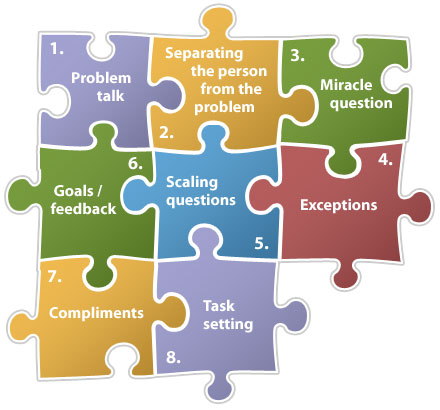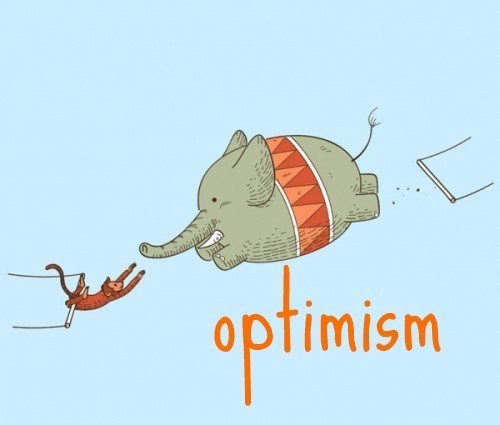By Matthew Mitchell @WilsonPractice w/ DrSteve @SportsShrink
Solution Focused Brief Therapy (SFBT)
SFBT is a form of treatment that invites an individual to discuss and generate an idea of their preferred future and set goals to work towards the vision of their preferred future.
A Solution Focused Therapist works to identify the client’s progress towards the preferred future and bring the client into awareness of their progress.

While several forms of therapy (e.g., psychoanalysis) focus on an individual’s experience of past events that contributed to the problem/challenge, Solution Focused Brief Therapy primarily works within the present and future orientations.
A Solution Focused Therapist would likely asked questions like, “Where are you now regarding your goal to lose weight?” or “Where do you hope to be in three months regarding your weight lose goal?”
The Solution Focused Therapist my revisit an individual’s past to discuss coping tools and past successes the person has experienced, but primarily the Solution Focused sessions will concentrate on current and future events.
The therapist may revisit the past as a means to identify what is similar or different about the client’s current situation and a time in the past when the current challenge did not exist or was less troubling.
A Solution Focused Therapist may ask, “Was there a time when you were okay with your weight and body image?” “What is different about your current situation and how you felt when you were more acceptable of your weight and body image?”

A basic understanding of the SFBT treatment approach is embodied in the acronym: M.E.C.S.T.A.T.
M – Miracle Questions
E – Exception Questions
C – Coping Questions
S – Scaling Questions
T – Time-Out
A – Accolades
T – Task
Miracle Questions:
The Miracle Question involves the therapist asking the client to think about the future and what it would be like if their concern no longer existed. This helps the client shape their preferred future and establish goals for work.
A Solution Focused Therapist may ask:
“What if you went home today, a miracle happened, and your problem disappeared?”
The therapist would allow the client time to process what their lives would be like without their current concern/problem and then ask:
“What would your life be like?”
Once the client and therapist process The Miracle Question, the therapist can follow up by scaling where the client feels like they are in relation to their preferred future. The therapist might ask:
“On a scale from 0-10, 0- being the worst things have been, 10- being a time when you no longer have this problem/concern, where do you feel like you are today?”
Exception Seeking Questions:
In Solution Focused Brief Therapy (SFBT), the therapist operates under the assumption that there has been a time in the client’s life when the problem/challenge either did not exist or was present in a less severe form.
The goal is for the therapist to work with the client to identify these occurrences and emulate them in the client’s current and future lives. The idea is that the client develops an understanding that they have either coped or lived without the problem in the past, and they have the ability to do it again.
The therapist may ask:
“Tell me about a time when you were not bothered by your weight/body image? What was different back then? What has worked for you in the past? How can you incorporate the practices that have worked in the past into your current life?”
Coping Questions:
Coping Questions are used to support the client’s self-efficacy. Regardless of how debilitating a problem/concern may seem, the client is living and is making efforts to work towards change. Coping Questions can be seen as a method to improve the client’s belief that they are in control of their problem/concern.
The therapist may ask:
“I see that things have been difficult for you recently. How are you continuing to get through each day? What has made you strong enough to come in to the office today to see me?”
With the Coping Questions, the therapist does not work to minimize the client’s problem/concern but rather validates their experience. The therapist utilizes the second portion as a way for the client to identify what resources they are utilizing to cope with their experience.
This tool moves away from the problem focused discussion and begins hi-lighting what is currently working for the client and possible solutions to build upon.
Scaling Questions:
Scaling Questions involve the client tracking their progress towards their goals (preferred future).
When using a scaling question, the therapist may ask:
“On a scale of 0-10, 0- being the worst things have ever been, 10- being the problem no longer exist, where are you today with your preferred future of no longer being bothered by your weight/body image?”
The client would then absorb the question and provide a concrete numerical designation for their current experience.
The therapist may ask follow up questions like:
“What would it take for you to move up one number?”
The client may respond:
“Losing 2 pounds.”
Time Out:
A Solution Focused Therapist will traditionally utilize a brief break or “time out” to reflect on the developments of the current session. This occurs during the second portion of the session and is preceded by the therapist asking the client if there is anything that the therapist has not asked that the client feels like would be important for the therapist to know.
Accolades:
During the brief break, the client is complimented for their efforts during the treatment session. It is important that the therapist display genuineness during this time period. Clients are sensitive to this aspect of the therapist/client relationship.
The therapist may say:
“When we discussed your coping resources, you quickly identified that you deal with your body image concerns by focusing on other areas of your life like your social relationships and your interests in movie development. This tells me that you really value your friendships and craft.”
Task:
During the Task portion of the SFBT treatment session, the therapist invites the client to discuss what behaviors may help them move towards their preferred future. The client brainstorms several tasks and discuss their willingness to participate or perform each task.
The therapist assigns a task for work based upon the client’s reported willingness to participate and their stage of change. It is important that the therapist realize that the client may or not be ready for each task they generated during the brainstorming portion of the session.

It is important for practitioners to realize that not every client will benefit from Solution Focused Brief Therapy. Practitioners should consider developing diverse clinical skills and use the orientation or theory that will best serve each individual client based upon client specificity.








 sending...
sending...